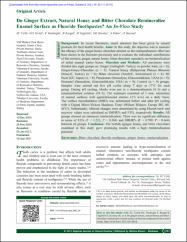Do ginger extract, natural honey and bitter chocolate remineralize enamel surface as fluoride toothpastes? An in-vitro study

Göster/
Erişim
info:eu-repo/semantics/openAccessAttribution-NonCommercial-ShareAlike 4.0 Internationalhttps://creativecommons.org/licenses/by-nc-sa/4.0/Tarih
2021Yazar
Çelik, Z. C.Özbay Yavlal, Gizem
Yanıkoğlu, Funda
Kargül, Betül
Tağtekin, Dilek
Stookey, George K.
Peker, Sertaç
Hayran, Osman
Üst veri
Tüm öğe kaydını gösterKünye
Çelik, Z. C., Özbay Yavlal, G., Yanıkoğlu, F., Kargül, B., Tağtekin, D., Stookey, G. K. ... Hayran, O. (2021). Do ginger extract, natural honey and bitter chocolate remineralize enamel surface as fluoride toothpastes? An in-vitro study. Nigerian Journal of Clinical Practice, 24(9), 1283-1288. https://dx.doi.org/10.4103/njcp.njcp_683_20Özet
Background: In recent literatures, much attention has been given to natural products for their health benefits. Aims: In this study, the objective was to measure the efficacy of the ginger-honey-chocolate mixture as the remineralization effect has been shown in the literature previously and to evaluate the individual contributions of this mixture; ginger, natural honey, bitter chocolate separately on remineralization of initial enamel caries lesion. Materials and Methods: All specimens were divided into eight groups as: Ginger (Arifoglu®, Turkey) in powder form, (n = 8); Ginger-Honey-Chocolate (n = 8); Natural honey (Balparmak Plateau Blossom Honey®, Turkey) (n = 9); Bitter chocolate (Nestlé®, Switzerland) (n = 8); MI Paste (GC, Japan) (n = 8); Paradontax (Sensodyne, Glaxosmithklein, USA) (n = 9); Pronamel (Sensodyne, Glaxosmithklein, USA) (n = 9); Control (n = 9) groups. Samples were carried out five pH cycles along 7 days at 37°C for each group. During pH cycling, blocks were put in a demineralization (6 h) and a remineralization solution (18 h). The treatment consisted of 1 min. interaction of enamel surfaces with agent/deionized slurries (1:3 w/w) on a daily basis. The surface microhardness (SMH) was determined before and after pH cycling with a Digital Micro-Vickers Hardness Tester (Wilson Wolpert; Europe BV, 401 MVD, Netherlands). Mineral changes were determined by using FluoreCam® and recovery values were calculated as SMHR% and FΔ%, respectively. Results: All groups showed an enhanced remineralization. There was no significant difference in terms of FΔ% (F = 1.223, P = 0.304) and SMHR% (F = 0.709, P = 0.664) between all groups. Conclusion: The herbals (ginger, honey, and bitter chocolate) examined in this study gave promising results with a high remineralization potential.
Scopus Q Kategorisi
Q3Kaynak
Nigerian Journal of Clinical PracticeCilt
24Sayı
9Koleksiyonlar
- Makale Koleksiyonu [3812]
- PubMed İndeksli Yayınlar Koleksiyonu [4283]
- Scopus İndeksli Yayınlar Koleksiyonu [6654]
- WoS İndeksli Yayınlar Koleksiyonu [6727]


















